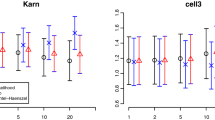Abstract
A class of tests for the hypothesis that the baseline intensity belongs to a parametric class of intensities is given in the recurrent event setting. Asymptotic properties of a weighted general class of processes that compare the non-parametric versus parametric estimators for the cumulative intensity are presented. These results are given for a sequence of Pitman alternatives. Test statistics are proposed and methods of obtaining critical values are examined. Optimal choices for the weight function are given for a class of chi-squared tests. Based on Khmaladze’s transformation we propose distributional free tests. These include the types of Kolmogorov–Smirnov and Cramér–von Mises. The tests are used to analyze two different data sets.
Similar content being viewed by others
References
Agustin M, Peña E (2001) Goodness-of-fit of the distribution of time-to-first-occurrence in recurrent event models. Lifetime Data Anal 7(3): 289–306
Agustin MZN, Peña EA (2005) A basis approach to goodness-of-fit testing in recurrent eventmodels. J Stat Plan Inference 133(2): 285–303
Andersen P, Borgan Ø, Gill R, Keiding N (1993) Statistical models based on counting processes. Springer series in statistics. Springer-Verlag, New York
Block H, Borges W, Savits T (1985) Age-dependent minimal repair. J Appl Probab 22(2): 370–385
Brown M, Proschan F (1983) Imperfect repair. J Appl Probab 20(4): 851–859
Dorado C, Hollander M, Sethuraman J (1997) Nonparametric estimation for a general repair model. Ann Stat 25(3): 1140–1160
Hjort NL (1990) Goodness of fit tests in models for life history data based on cumulative hazard rates. Ann Stat 18(3): 1221–1258
Hollander M, Presnell B, Sethuraman J (1992) Nonparametric methods for imperfect repair models. Ann Stat 20(2): 879–896
Khmaladze ÈV (1981) A martingale approach in the theory of goodness-of-fit tests. Teor Veroyatnost i Primenen 26(2): 246–265
Khmaladze ÈV (1988) An innovation approach to goodness-of-fit tests in R m. Ann Stat 16(4): 1503–1516
Khmaladze ÈV (1993) Goodness of fit problem and scanning innovation martingales. Ann Stat 21(2): 798–829
Kumar U, Klefsjö B (1992) Reliability analysis of hydraulic systems of lhd machines using the power law process model. Reliab Eng Syst Saf 35: 217–224
Last G, Szekli R (1998) Asymptotic and monotonicity properties of some repairable systems. Adv Appl Probab 30(4): 1089–1110
Neyman J (1937) “Smooth test” for goodness of fit. Skand Aktuarietidskr 20: 149–199
Peña EA (1998) Smooth goodness-of-fit tests for composite hypothesis in hazard based models. Ann Stat 26(5): 1935–1971
Peña EA (1998) Smooth goodness-of-fit tests for the baseline hazard in Cox’s proportional hazards model. J Am Stat Assoc 93(442): 673–692
Peña E, Hollander M (2004) Models for recurrent events in reliability and survival analysis. In: Mathematical reliability: an expository perspective. Kluwer Academic Publishers, Dordrecht, pp 105–118
Peña E, Strawderman R, Hollander M (2000) A weak convergence result relevant in recurrent and renewal models. In: Recent advances in reliability theory (Bordeaux 2000), Stat Ind Technol. Birkhäuser Boston, Boston, pp 493–514
Peña E, Strawderman R, Hollander M (2001) Nonparametric estimation with recurrent event data. J Am Stat Assoc 96(456): 1299–1315
Peña E, Slate E, González J (2007) Semiparametric inference for a general class of models for recurrent events. J Stat Plan Inference 137(2): 1727–1747
Presnell B, Hollander M, Sethuraman J (1994) Testing the minimal repair assumption in an imperfect repair model. J Am Stat Assoc 89(425): 289–297
Proschan F (1963) Theoretical explanation of observing decreasing failure rate. Technometrics 5: 375–383
Sellke T (1988) Weak convergence of the Aalen estimator for a censored renewal process. In: Gupta S, Berger J (eds) Statistical decision theory and related topics, IV, vol 2 (West Lafayette, Ind., 1986). Springer, New York, pp 183–194
Stocker R, Peña E (2007) A general class of parametric models for recurrent event data. Technometrics 49(2): 210–220
Sun Y (1997) Weak convergence of the generalized parametric empirical processes and goodness-of-fit tests for parametric models. Commun Stat Theory Methods 26(10): 2393–2413
Sun Y, Tiwari RC, Zalkikar JN (2001) Goodness of fit tests for multivariate counting process models with applications. Scand J Stat 28(1): 241–256
Author information
Authors and Affiliations
Corresponding author
Rights and permissions
About this article
Cite this article
Stocker, R.S., Adekpedjou, A. Optimal goodness-of-fit tests for recurrent event data. Lifetime Data Anal 17, 409–432 (2011). https://doi.org/10.1007/s10985-011-9193-1
Received:
Accepted:
Published:
Issue Date:
DOI: https://doi.org/10.1007/s10985-011-9193-1



